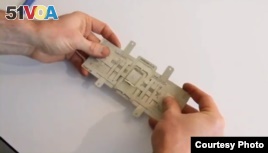27 June, 2014
From VOA Learning English, this is As It Is.
Today we hear about a recent development in microscope technology. Now, you might think this will be about a costly and complex high-tech machine. You would be wrong. What if I were to tell you that the latest in microscope technology is so low-tech you can make it yourself?

The Do-It-Yourself (DIY) Foldscope is powerful, durable and cheap. What more could you ask for in a microscope?
Christopher Cruise has more.
The One-dollar D.I.Y. Microscope
New scientific discoveries often use the latest technology. But a new microscope is just the opposite.
The Foldscope is a microscope made from folded paper. It is like origami, the ancient Japanese art of folding paper, except for laboratories.
The design of Foldscope is simple. It takes only ten minutes to put together the paper board. But the microscope is powerful. Its tiny lens can magnify objects up to 2,000 times.
And the best part is – it only costs one dollar.
One of the co-designers of Foldscope is a bioengineer at Stanford University. Manu Prakash says Foldscope could help developing countries that have severe problems with diseases such as malaria. The World Health Organization estimates the disease killed more than 600,000 people in 2012.
He says it is important to know which kind of malaria the patient has -- or if she has malaria at all.
Manu Prakash: "There are many different strains, there are many different medications, and you could potentially make the problem even worse."
Microscopes are necessary tools for identifying what is causing a patient to be sick. But in the developing world microscopes are often broken. Duke University bioengineer Robert Malkin says that the number of broken microscopes is high and they are costly to replace.
Robert Malkin: "It's pretty amazing, actually. The number of broken microscopes is overwhelming. We work in hundreds, maybe thousands, of hospitals around the world. None of our hospitals can afford to buy a microscope. They're far too expensive."
Enter Foldscope. The most expensive part of Foldscope is the high-power lens, a 56-cent ball of glass. The low-power lens only costs 17 cents.
Foldscope does not cost a lot but it is strong. To prove that point, workers in a laboratory dropped one from a three-story building and stepped on it. It still worked.
Robert Malkin says Foldscope is a step in the right direction. But he says there are many other issues to consider before a microscope actually works well in the field.

A student learns to use a microscope.
One of those issues is human training.
Aurelie Jeandron works to improve the availability of clean water and sanitation at the London School of Hygiene and Tropical Medicine. She says that a microscope without a trained person behind it is useless.
But Ms. Jeandron adds that Foldscope could be a useful educational tool. She says if people could see the microbes in water that make them sick, it could help change their behavior.
Ms. Jeandron: "That might also help people change their behaviors and their beliefs in terms of disease."
Mr. Prakash admits that there is a "training gap" in developing-world healthcare. But he hopes that making medical tools available will be a step forward.
Mr. Prakash is also on a mission. He wants to put microscopes in the hands of people around the world.
His group is launching the "Ten Thousand Microscopes Project." It aims to provide Foldscopes to volunteers around the world. They will field-test the Foldscope and invent their own ways to use it. People from 130 countries have signed up. He hopes to provide all the microscopes by September of this year.
I'm Christopher Cruise.
And I'm Anna Matteo.
Use our comment section to practice the expressions in this story.